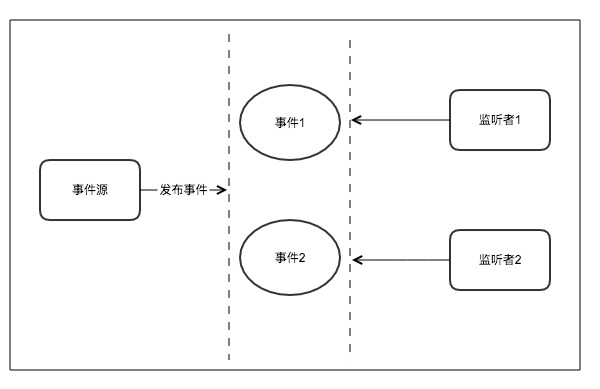Spring Cloud Bus中的事件的订阅与发布(一)
年前最后一篇博客更新,提前祝大家新年快乐(还有情人节)!
下面进入正题。Spring Cloud Bus用轻量级的消息代理将分布式系统的节点连接起来。这可以用来广播状态的该表(比如配置的改变)或者其他关联的指令。一个关键的想法是,总线就像是一个分布式Actuator,用于Spring Boot应用程序的扩展,但它也可以用作应用程序之间的通信通道。Spring Cloud提供了AMQP 传输的代理和Kafka启动Starters,对具有相同的基本功能集的其他传输组件的支持,也在未来的规划中。
Spring Cloud Bus
Spring Cloud Bus 是在 Spring Cloud Stream 的基础上进行的封装,对于指定主题的消息的发布与订阅是通过 Spring Cloud Stream 的具体binder实现。因此引入的依赖可以是 spring-cloud-starter-bus-amqp 和 spring-cloud-starter-bus-kafka 其中的一种,分别对应于binder的两种实现。根据上一节的基础应用,我们总结出 Spring Cloud Bus 的主要功能如下两点:
- 对指定主题
springCloudBus的消息订阅与发布。 - 事件监听,包括刷新事件、环境变更事件、远端应用的ack事件以及本地服务端发送事件等。
下面我们以这两方面作为主线,进行 Spring Cloud Bus 的源码分析。本文主要针对事件的订阅户发布。
事件的订阅与发布
事件驱动模型
这部分需要读者首先了解下Spring的事件驱动模型。我们在这边简单介绍下设计的主要概念,帮助大家易于理解后面的内容。

Spring的事件驱动模型由三部分组成:
- 事件:ApplicationEvent,继承自JDK的EventObject,所有事件将继承它,并通过source得到事件源。
- 事件发布者:ApplicationEventPublisher及ApplicationEventMulticaster接口,使用这个接口,我们的Service就拥有了发布事件的能力。
- 事件订阅者:ApplicationListener,继承自JDK的EventListener,所有监听器将继承它。
事件的定义
Spring的事件驱动模型的事件定义均继承自 ApplicationEvent , Spring Cloud Bus 中有多个事件类,这些事件类都继承了一个重要的抽象类 RemoteApplicationEvent ,我们看一下事件类的类图:

涉及的事件类有:代表了对特定事件确认的事件 AckRemoteApplicationEvent 、环境变更的事件 EnvironmentChangeRemoteApplicationEvent 、刷新事件 RefreshRemoteApplicationEvent 、发送事件 SentApplicationEvent 、以及未知事件 UnknownRemoteApplicationEvent 。下面我们分别看一下这些事件的定义。
抽象基类:RemoteApplicationEvent
通过上面的类图,我们知道 RemoteApplicationEvent 是其他事件类的基类,定义了事件对象的公共属性。
@JsonTypeInfo(use = JsonTypeInfo.Id.NAME, property = "type") //序列化时使用子类的名称作为type
@JsonIgnoreProperties("source") //序列化时,忽略 source
public abstract class RemoteApplicationEventextends ApplicationEvent{
private static final Object TRANSIENT_SOURCE = new Object();
private final String originService;
private final String destinationService;
private final String id;
protected RemoteApplicationEvent(Object source, String originService,
String destinationService) {
super(source);
this.originService = originService;
if (destinationService == null) {
destinationService = "**";
}
if (!"**".equals(destinationService)) {
if (StringUtils.countOccurrencesOf(destinationService, ":") <= 1
&& !StringUtils.endsWithIgnoreCase(destinationService, ":**")) {
//destination的所有实例
destinationService = destinationService + ":**";
}
}
this.destinationService = destinationService;
this.id = UUID.randomUUID().toString();
}
...
}
在 RemoteApplicationEvent 中定义了主要的三个通用属性事件的来源originService、事件的目的服务destinationService和随机生成的全局id。通过其构造方法可知,destinationService可以使用通配符的形式{serviceId}:{appContextId},两个变量都省略的话,则通知到所有服务的所有实例。只省略appContextId时,则对应的destinationService为相应serviceId的所有实例。另外,注解 @JsonTypeInfo(use = JsonTypeInfo.Id.NAME, property = "type") 对应于序列化时,使用子类的名称作为type;而 @JsonIgnoreProperties("source") 表示序列化时,忽略source属性,source定义在JDK中的 EventObject 。
EnvironmentChangeRemoteApplicationEvent
用于动态更新服务实例的环境属性,我们在基础应用中更新 cloud.version 属性时,关联到该事件。
public class EnvironmentChangeRemoteApplicationEventextends RemoteApplicationEvent{
private final Map<String, String> values;
public EnvironmentChangeRemoteApplicationEvent(Object source, String originService,
String destinationService, Map<String, String> values) {
super(source, originService, destinationService);
this.values = values;
}
...
}
可以看到, EnvironmentChangeRemoteApplicationEvent 事件类的实现很简单。定义了Map类型的成员变量,key对应于环境变量名,而value对应更新后的值。
RefreshRemoteApplicationEvent
刷新远端应用配置的事件,用于接收远端刷新的请求。
public class RefreshRemoteApplicationEventextends RemoteApplicationEvent{
public RefreshRemoteApplicationEvent(Object source, String originService,
String destinationService) {
super(source, originService, destinationService);
}
}
继承自抽象事件类 RemoteApplicationEvent ,没有特别的成员属性。
AckRemoteApplicationEvent
确认远端应用事件,该事件表示一个特定的 RemoteApplicationEvent 事件被确认。
public class AckRemoteApplicationEventextends RemoteApplicationEvent{
private final String ackId;
private final String ackDestinationService;
private Class<? extends RemoteApplicationEvent> event;
public AckRemoteApplicationEvent(Object source, String originService,
String destinationService, String ackDestinationService, String ackId,
Class<? extends RemoteApplicationEvent> type) {
super(source, originService, destinationService);
this.ackDestinationService = ackDestinationService;
this.ackId = ackId;
this.event = type;
}
...
public void setEventName(String eventName){
try {
event = (Class<? extends RemoteApplicationEvent>) Class.forName(eventName);
} catch (ClassNotFoundException e) {
event = UnknownRemoteApplicationEvent.class;
}
}
}
该事件类在 RemoteApplicationEvent 基础上,定义了成员属性ackId、ackDestinationService和event。
ackId和ackDestinationService,分别表示确认的时间的id和对应的目标服务。event对应事件类型,确认事件能够确认的必然是 RemoteApplicationEvent 的子类,因此event属性设值时需要进行检查,如果转换出现异常,则定义为未知的事件类型。这些事件可以被任何需要统计总线事件响应的应用程序来监听。 它们的行为与普通的远程应用程序事件相似,即如果目标服务与本地服务ID匹配,则应用程序会在其上下文中触发该事件。
SentApplicationEvent
发送应用事件,表示系统中的某个地方发送了一个远端事件。
@JsonTypeInfo(use = JsonTypeInfo.Id.NAME, property = "type")
@JsonIgnoreProperties("source")
public class SentApplicationEventextends ApplicationEvent{
private static final Object TRANSIENT_SOURCE = new Object();
private final String originService;
private final String destinationService;
private final String id;
private Class<? extends RemoteApplicationEvent> type;
protected SentApplicationEvent(){
// for serialization libs like jackson
this(TRANSIENT_SOURCE, null, null, null, RemoteApplicationEvent.class);
}
public SentApplicationEvent(Object source, String originService,
String destinationService, String id,
Class<? extends RemoteApplicationEvent> type) {
super(source);
this.originService = originService;
this.type = type;
if (destinationService == null) {
destinationService = "*";
}
if (!destinationService.contains(":")) {
// All instances of the destination unless specifically requested
destinationService = destinationService + ":**";
}
this.destinationService = destinationService;
this.id = id;
}
...
}
可以看到该事件类继承自 ApplicationEvent ,它本身并不是一个 RemoteApplicationEvent 事件,所以不会通过总线发送,而是在本地生成(多为响应远端事件)。想要审计远端事件的应用可以监听该事件,并且所有的 AckRemoteApplicationEvent 事件中的id来源于相应的 SentApplicationEvent 中定义的id。在其定义的成员属性中,相比于远端应用事件多了一个事件类型type,该类型限定于 RemoteApplicationEvent 的子类。
UnknownRemoteApplicationEvent
未知的远端应用事件,也是 RemoteApplicationEvent 事件类的子类。该事件类与之前的 SentApplicationEvent 、 AckRemoteApplicationEvent 有关,当序列化时遇到事件的类型转换异常,则自动构造成一个未知的远端应用事件。










![[HBLOG]公众号](https://www.liuhaihua.cn/img/qrcode_gzh.jpg)

